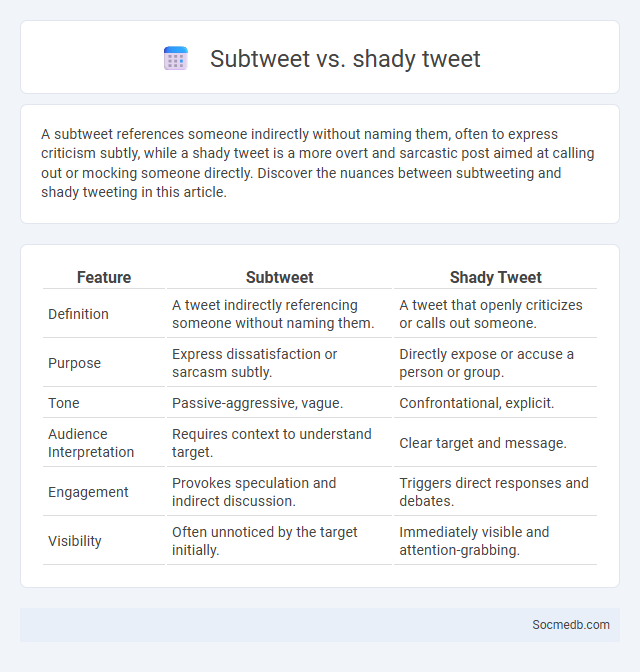
Photo illustration: Subtweet vs Shady Tweet
A subtweet references someone indirectly without naming them, often to express criticism subtly, while a shady tweet is a more overt and sarcastic post aimed at calling out or mocking someone directly. Discover the nuances between subtweeting and shady tweeting in this article.
Table of Comparison
| Feature | Subtweet | Shady Tweet |
|---|---|---|
| Definition | A tweet indirectly referencing someone without naming them. | A tweet that openly criticizes or calls out someone. |
| Purpose | Express dissatisfaction or sarcasm subtly. | Directly expose or accuse a person or group. |
| Tone | Passive-aggressive, vague. | Confrontational, explicit. |
| Audience Interpretation | Requires context to understand target. | Clear target and message. |
| Engagement | Provokes speculation and indirect discussion. | Triggers direct responses and debates. |
| Visibility | Often unnoticed by the target initially. | Immediately visible and attention-grabbing. |
Understanding Subtweets: A Modern Social Media Phenomenon
Subtweets are indirect social media posts that reference a specific person without tagging them, often used to express opinions or criticisms covertly. Understanding subtweets helps you navigate digital communication nuances and decode underlying messages in online interactions. This awareness enhances your ability to engage thoughtfully and interpret conversations on platforms like Twitter and Instagram.
What Defines a Shady Tweet? Key Characteristics
A shady tweet typically features misleading information, ambiguous language, or intent to deceive or manipulate the audience. It often employs vague or emotionally charged words to provoke reactions without providing clear facts or context. Patterns such as frequent use of sensationalism, lack of credible sources, and aggressive tone further define its questionable nature on social media platforms.
Subtweet vs. Shady Tweet: Spotting the Differences
Subtweeting involves posting indirect messages on social media aimed at someone without naming them, creating subtle drama that sparks curiosity among followers. Shady tweets are more overtly negative or mocking, often hinting at disapproval or criticism while maintaining plausible deniability. Recognizing the difference helps users interpret online conflicts and social cues within platforms like Twitter and Instagram.
Origins and Evolution of Subtweeting
Subtweeting originated as a discreet way for users to comment on others without direct mentions, emerging prominently on Twitter around 2011. This form of indirect communication evolved alongside social media's growth, reflecting shifting user behaviors toward subtlety and nuanced social dynamics. Understanding subtweeting helps You navigate modern digital interactions where implicit messages often carry significant social weight.
Why People Use Subtweets: Motivations and Intentions
People use subtweets to express opinions or feelings indirectly, avoiding direct confrontation while still addressing specific individuals or groups. These messages often serve as a way to vent frustrations, seek social validation, or signal alignment with certain social circles. Understanding your motivations behind subtweeting can help manage online relationships and navigate social dynamics more effectively.
The Art of the Shady Tweet: Subtle Insults Online
Mastering The Art of the Shady Tweet requires a keen understanding of sarcasm, timing, and cultural context to deliver subtle insults effectively without crossing into overt aggression. Your skillful use of ambiguity and indirectness allows you to engage followers while sparking conversations that drive engagement through clever, nuanced commentary. Social media platforms thrive on such witty exchanges, amplifying your online presence through viral, memorable content that balances humor and criticism.
Impacts of Subtweets and Shady Tweets on Online Relationships
Subtweets and shady tweets often create misunderstandings and mistrust among social media users, significantly damaging online relationships. These indirect or ambiguous posts foster speculation and conflict, disrupting communication and leading to social alienation. The resulting emotional strain underscores the importance of transparency and direct communication in digital interactions.
Social Media Etiquette: Dealing with Subtweets and Shady Tweets
Navigating social media etiquette requires understanding how to handle subtweets and shady tweets with tact and discretion. You should avoid escalating conflicts by responding publicly; instead, address concerns privately or choose not to engage if the tone is intentionally vague or hostile. Maintaining professionalism and restraint helps protect your online reputation and fosters a respectful digital environment.
Examples: Real-World Subtweets vs. Shady Tweets
Real-world subtweets mimic subtle, indirect social media posts that hint at issues without naming individuals, often seen in platforms like Twitter or Instagram Stories. Shady tweets, in contrast, explicitly use vague or misleading language to provoke controversy or drama, frequently involving accusations or gossip without providing clear context. Understanding these differences helps you navigate online interactions more thoughtfully and avoid miscommunication or unnecessary conflict.
Which is Worse? Subtweeting or Shady Tweeting
Subtweeting often feels more passive-aggressive, as it targets individuals indirectly, creating ambiguity and fueling speculation among followers. Shady tweeting, by contrast, involves direct veiled insults or cryptic references that can escalate conflicts quickly due to their pointed nature. Both can damage online reputations, but subtweeting's covert approach tends to generate prolonged tension by fostering uncertainty and audience guessing.
 socmedb.com
socmedb.com